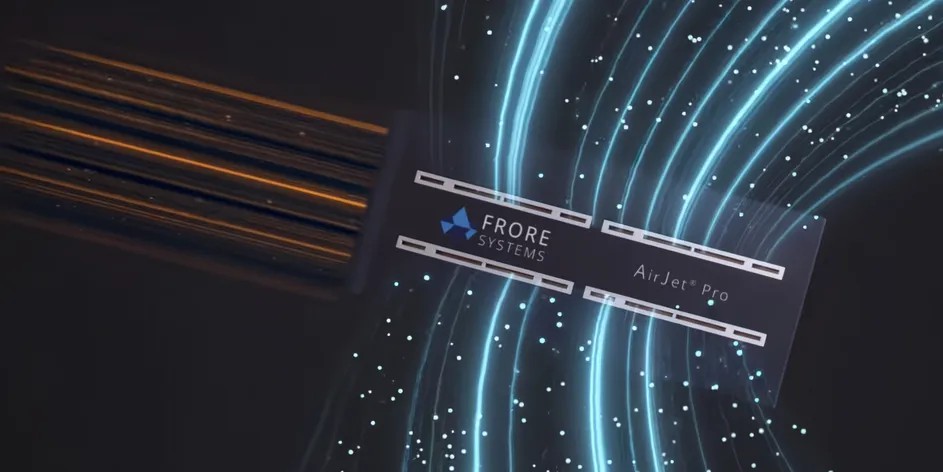Heat as a Limiting Factor and the Need for Cooling Solutions
Heat poses a significant limitation when it comes to achieving powerful chips in small devices. Even devices like the iPhone 14 Pro Max experience a decline in performance after a few minutes of intense usage to prevent damage caused by excessive heat.
Currently, passive cooling or cooling fans are the primary methods used to cool small devices such as smartphones and thin-and-light laptops. However, passive cooling is not effective enough for modern high-power chips, while cooling fans require considerable space.
Introduction of the Frore AirJet
Frore has introduced a new cooling solution called the AirJet Mini and AirJet Pro, which revolutionizes the traditional cooling approach. Instead of relying on fans, Frore has developed a thin wafer-like device capable of propelling air at speeds of up to 200 km/h. This innovative device consists of a copper base to absorb heat, four small intakes equipped with paper filters, a flexible printed circuit board for control, and an exhaust port to release the high-speed air.
The Unique Air Movement Mechanism
What sets the AirJet apart is its method of moving air, which diverges from conventional rotary fans or pumps. Instead, it leverages technology developed in the late 1800s to achieve its airflow.

Revolutionizing PC Cooling with the Frore AirJet
When people think of air cooling for PCs, they typically envision a rotary fan as the primary means of generating airflow. However, this approach comes with a significant drawback: the motor that drives the fan occupies a considerable amount of space. Due to size limitations, even the smallest rotary fans available on the market measure around 9mm x 9mm x 3mm as of the time of writing.
While this size may seem small, it remains inadequate for certain applications. Moreover, these miniature fans are unable to generate the necessary airflow required for cooling high-power chips effectively.
In contrast to traditional rotary fans, Frore employs piezoelectric components to drive air using their active cooling chip. The AirJet, as the company calls it, is referred to as a “solid-state thermal solution” since it lacks visible moving parts, akin to the distinction between a hard disk drive (HDD) and a solid-state drive (SSD).
Piezoelectricity, discovered by the Curie brothers in 1880, refers to the phenomenon exhibited by certain materials that generate electricity when subjected to mechanical stress. Engineers and scientists were able to reverse this process, creating materials that change shape in response to an electrical current.
By alternating the current, they developed a compact device that rapidly moves back and forth without the need for a rotary engine, much like the motion of using a paper fan to cool oneself on a hot summer day.

AirJet Mini: Impressive Airflow and Cooling Potential
The AirJet Mini, measuring 41.5mm x 27.5mm x 2.8mm, has remarkable airflow capabilities. It can move 5.95 liters of air per minute, which is nearly five times more than Sunon’s 9mm x 9mm x 3mm rotary fan, and equivalent to the airflow volume of a 12mm x 12mm x 3mm fan.
Notably, it boasts an impressive back pressure of 1,750 Pascal, allowing it to draw significant amounts of air through narrow openings without the need for large air intake vents. This reduces the risk of dust and water entering devices that utilize the AirJet for cooling.
According to Frore, a single AirJet Mini can dissipate 5.25 watts of heat while operating at a noise level of 21 dB. Although it may not be sufficient for demanding high-performance chips like the Intel Core i9-13900K or the AMD Ryzen 9 7950X3D, it enables the installation of relatively more powerful processors such as the 13th-Generation Intel Core i3 in compact packages like Intel NUCs or even smaller devices.
The Arrival of AirJet in Smartphones and Laptops
Given the promising capabilities of the AirJet, the question arises: when will we see it integrated into our devices? The technology was unveiled at Computex 2023 in May, so it will take some time before manufacturers incorporate it into their products.
However, we have already witnessed a prototype from a reputable manufacturer. ZOTAC announced the ZBOX PI430AJ mini PC, an upgrade to their line of ultra-compact computers. Thanks to the exceptional cooling provided by the AirJet, ZOTAC was able to equip the ZBOX with a much more powerful Intel Core i3 processor, surpassing their previous limitation of using Intel Celeron chips due to size constraints.
Although the release date for the ZBOX PI430AJ is yet to be confirmed, we anticipate its availability within this year.
Advancing Cooling Technology: The AirJet’s Impact
While processor technology has made significant strides, cooling technology has been slower to catch up. However, with the emergence of the AirJet, air cooling is finally beginning to keep pace with the rapid advancements in CPU development.
The introduction of the AirJet promises a future where our smartphones, laptops, and tablets can become even thinner without compromising performance. However, as we eagerly anticipate the integration of this technology into our devices, it is advisable to consider using a laptop cooling mat in the meantime. This can help enhance the performance of your current laptop and prevent overheating.


